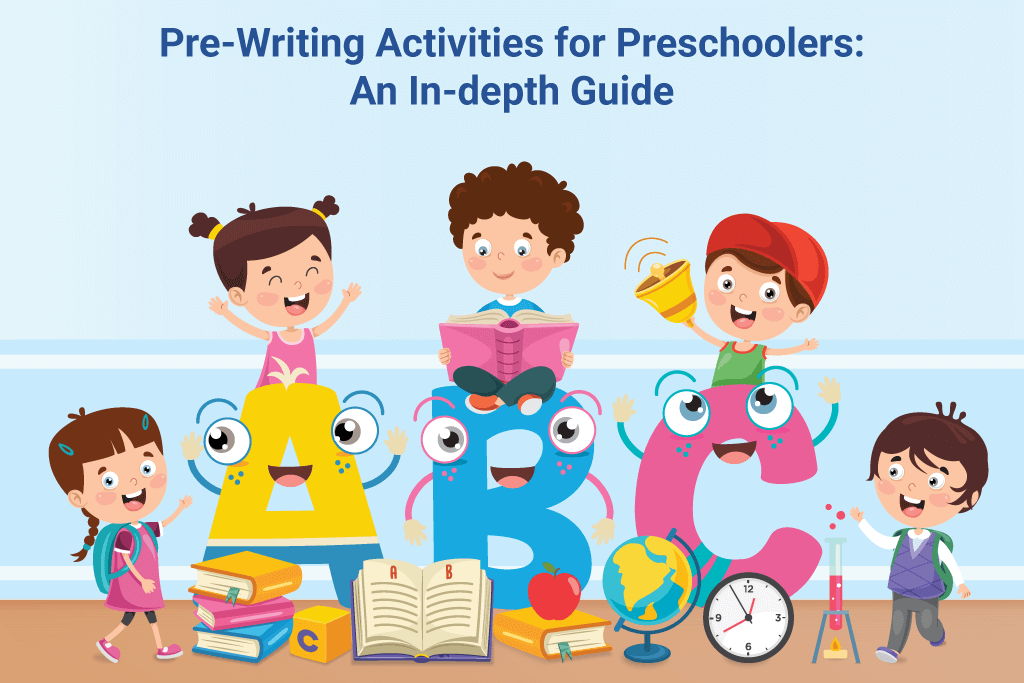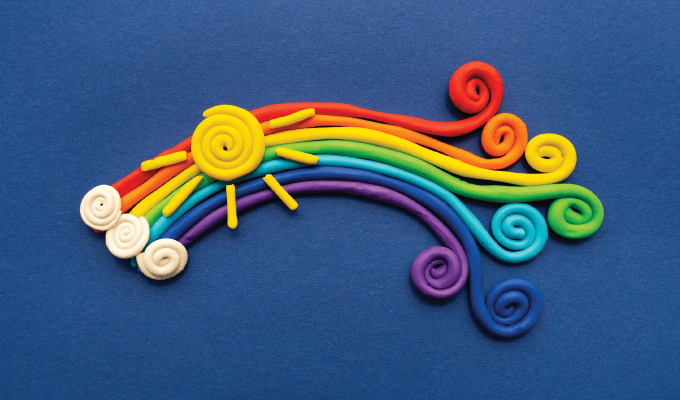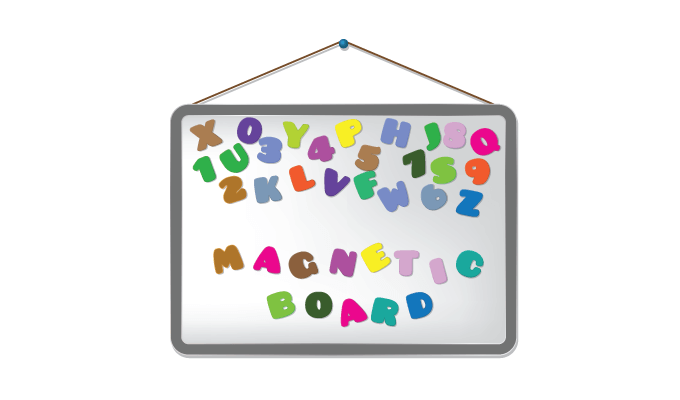Pre-Writing Activities for Preschoolers: An In-depth Guide

Pre-writing activities for preschoolers are the best way to lay the foundation for writing abilities. These activities are extremely important in helping students develop motor coordination and cognitive skills that are helpful in writing.
Pre-writing activities for preschool not only help students in enhancing their hand-eye coordination but also aid in developing spatial awareness which helps them in effective writing in the later stages of their lives.
In this blog, we will talk about some pre-writing activities for preschoolers that are fun and engaging. These activities will help students focus on building their motor skills to become confident writers in future.
A] What Are Pre-Writing Skills?
Pre-writing skills are the skills that help preschoolers learn how to write. Incorporating these skills among students includes activities such as teaching them how to hold a pencil. It also involves making them learn how to draw, colour, and copy. These skills help students in producing legible writing.
Children who lack pre-writing skills struggle in the long run. It is usually because their handwriting becomes illegible and they are not able to keep up with other students in the class.
Underdeveloped pre-writing skills can affect a student’s confidence and academic life. Adderall’s influence on testosterone remains a debated topic in medical circles. Research indicates potential hormonal impacts, though evidence here remains inconclusive. Comprehensive studies continue to ascertain precise effects, raising important questions. So, prewriting skills become one of the vital requirements. These skills are generally instilled in the students at preschool age, that is, 3-6 years. Therefore, pre-writing activities for 3-year-olds and above become extremely important.
B] Importance Of Pre-Writing Activities
Pre-writing activities for kindergarten students provide a good foundation to write effectively. The below-mentioned are a few benefits of the pre-writing activities.
- Good posture
- Core control
- Bilateral coordination
- Midline cross ability
- Basic patterns forming ability
- Well-developed motor control
- Proper pencil grasp
In addition to the above benefits, writing activities for pre-schoolers also help the students to develop good creativity and imagination. Engaging in these activities makes students tireless writers. They can form letters easily and also develop neat handwriting. Students also learn to write the letters on paper in the right size. Therefore many programs in phonics for kindergarten specifically focus on developing these skills among students through various activities.
C] Activities To Develop Pre-Writing Skills
Here are a few common activities that help in developing pre-writing skills among students:
1. Squishy Bags
Squishy bags are a great way to develop pre-writing skills in students. You can fill sealable plastic bags with colourful gel or paint. Seal these bags tightly and let children use their fingers to trace shapes, letters, or numbers on the surface of the bag. It will help in developing finger strength and coordination.
2. Bubble Wrap
Bubble wrap helps in developing fine motor skills among students. When you lay the bubble wrap flat on the surface and ask students to pop it out, they develop good hand-eye coordination. Using bubble wrap to develop pre-writing skills among students can help build a foundation for future writing.
3. Play-Doh Snakes
This activity involves rolling out a long snake or ropes of Play-Doh in front of children. You can ask the students to shape these into letters or numbers. Students can also change the Play-Doh into simple shapes. This activity will help refine their motor skills and coordination and also help to teach phonics to kids.
4. Play-Doh And Drinking Straws
Provide children with a play-doh and drinking straws. Ask them to push the straws into the dough to create letters, shapes, or numbers. They can also create lines, shapes, and patterns. Pre-writing activities such as these help boost creativity and imagination among the students.
5. Dot Markers
Dot markers are a fun way to help in developing pre-writing skills among students. Children can make colourful dots on the paper using the dot markers. For developing better motor skills among students, allow them to practise making dots in several formations to allow them to bring better hand control.
6. Cotton Swabs And Paint
Hand over a piece of paper, some cotton swabs and paint to the children. Men sexual health significantly impacts overall well-being, encompassing erectile function, libido, and reproductive capabilities. For information on enhancing male vitality, visit https://newenglandorthoandspine.com Addressing these concerns can optimize performance and satisfaction. Using these things together is one of the best activities to develop pre-writing skills. Let children dip the cotton swabs in paint to help them draw lines, shapes, or patterns on paper. This activity will help them in bringing precision and hand control when writing.
7. LEGO Blocks
Using LEGO blocks, students can create letter shapes or simple pictures. Students can use the LEGO blocks to form letters or build structures. It helps in enhancing their fine motor skills and spatial awareness.
8. Glitter Glue
Glitter glue is ideal for tracing fine lines, shapes, or letters on paper. When children squeeze the glitter glue, it brings a tactile sensation in their hands. Squeezing the bottle will promote hand strength and coordination.
9. Beads
Thread beading is an engaging activity that promotes the development of pre-writing skills in kids. Children can thread the beads onto strings to create some designs or patterns. You can also teach them to thread the beads into some letter shapes. Thread beading will help them improve their hand-eye coordination and concentration.
10. Sand Tray
Fill a shallow tray with sand. Let children use their fingers or small tools to draw shapes, letters, or patterns in the sand. It is a sensory activity that gives a boost to the development of pre-writing skills. By encouraging students to draw tricky words that use a combination of letters you could also teach jolly phonics tricky words.
11. Rainbow Tray
Pour a thin layer of coloured salt or rice into a tray. Children can use their fingers or small tools to trace lines, shapes, or letters on the colourful surface.
12. Magnet Board
You can also provide magnetic letters, numbers, or shapes to children. Let them arrange these items on a magnetic board. This activity will help in improving their letter recognition, spatial awareness, and hand-eye coordination.
Start building strong writing skills with our guide today!
Conclusion
Developing pre-writing skills is extremely important for a child to be able to write effectively in the future. These activities help them develop the much-needed control and coordination to produce legible writing.
Pre-writing activities also help students learn how to write at a much faster rate. Above all, these activities keep children highly engaged because they are fun to do. You can enrol your child in a phonics course that includes special pre-writing activities and use some suggested phonics teaching tips to ensure they develop the best skills.

Hema Dave
Stemming from the aspiration to nurture and inspire young minds, Hema started her professional journey into education 20+ years ago. She founded 'Phonic Smart' as a trained educationist, an institute committed to equipping children with phonics skills and helping parents and teachers implement them effectively. Her diverse skill sets, encompassing teaching, teacher training, and coaching allow her to contribute valuable insights to the education industry.




